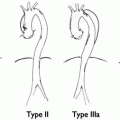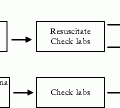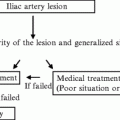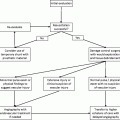Feature
Points
Size
Small (<3 cm)
1
Medium (3-6 cm)
2
Large (>6 cm)
3
Eloquence of adjacent brain
Noneloquent
0
Eloquent
1
Pattern of venous drainage
Superficial
0
Deep
1
5 Diagnosis
Many AVMs are diagnosed after they have become symptomatic by intracranial hemorrhage, new onset seizure, or headaches. A definitive diagnosis is made through radiographic imaging.
6 Diagnostic Imaging
Noncontrast head CTs are often utilized as a first line imaging modality, to evaluate for acute hemorrhage. MRIs provide more detailed information about previous hemorrhage and anatomy of the AVM with respect to the underlying brain parenchyma. Conventional angiography is the gold standard for the diagnosis and evaluation of brain AVMs. Conventional angiography is particularly essential for lesions which have hemorrhaged such that high-risk features (e.g., deep venous drainage, nidal aneurysms, limited venous outflow) can be defined.
7 Management
Small, surgically accessible AVMs may be resected without prior embolization. Some operators are now attempting endovascular treatment of these smaller lesions with the goal of achieving a complete obliteration of the nidus with embolic agents. Anatomically, larger lesions are usually treated with preoperative emboilzation followed by surgical resection. Lesions with a nidus measuring less than 3 cm may be amenable to treatment with radiosurgery. Conservative management (no treatment) also represents an important option, and in many cases (particularly with larger or eloquent AVMs), this represents the best option. In patients who present with an acute large hemorrhage, surgical evacuation of the hematoma may be the first step in management. When the patient becomes more stable, and the hematoma resolves, the decision to proceed with elective endovascular therapy can be made on an individual basis. In cases of smaller hemorrhages, patients should undergo noninvasive imaging with a contrast MRI and MRA as well as diagnostic angiography.
Following hemorrhage, patients should be kept under tight blood pressure control with systolic blood pressure not exceeding 120 mmHg. Antiepileptic prophylaxis is generally not recommended; however, in those patients who present with parenchymal hemorrhage, seizures, or later develop seizures, antiepileptics should be continued throughout the course of the therapy.
8 List of Open Operative Choices
Treatment options are largely dependent on the risk of hemorrhage or other focal neurologic deficit. They include the following:
1.
Radiosurgery—Used for total obliteration of smaller AVMs
2.
Total surgical resection
Once an AVM has been surgically cured, there is little to no chance of recurrence.
9 Intervention
9.1 Principles
The embolic agents used most frequently are n-butylcyanoacrylate (NBCA) (Trufill NBCA Liquid Embollic, Cordis Corp) and more recently ethylene-vinyl alcohol copolymer (Onyx) (ev3, Irvine, California). NBCA was introduced in the late 1980s as a fast-polymerizing liquid adhesive and polymerizes upon direct contact with blood. Because of its thrombogenic nature, exquisite skill is required to avoid injection into the vein that can lead to outflow occlusion and hemorrhage.
Onyx is a liquid embolic agent that is nonadhesive and polymerizes by precipitation instead of ionic contact, thereby reducing the risk of catheter adherence to the polymer. Onyx has become increasingly used due to its more straightforward handling characteristics, more controlled injections, and nidus penetration. Onyx is available in various viscosities with Onyx18 and Onyx 34 available for the preoperative embolization of brain AVMs. In most cases, Onyx 18 is used through injections of small arterial feeders in order to obtain nidus penetration. It may be preferable to use the more viscous Onyx 34 for cases with high-flow nidus shunting.
The decision to use either NBCA or Onyx is operator dependent, taking into account the AVM flow dynamics, anatomy, and ultimate goal in endovascular treatment. In general, there are six options for neuroendovascular therapy as follows:
Get Clinical Tree app for offline access
(a)
Preoperative embolization: This is performed in single or multiple procedures prior to complete surgical resection. This is the most common method utilized in moderate to large AVMs. The goal is to gradually decrease the size of the AVM by 80–90 by embolizing arterial pedicles, or selective embolizations targeted at locations with difficult surgical access. Generally, embolizations are performed in a stepwise fashion to minimize the risk of hemorrhage from dynamic flow-related changes. Interval timing between embolization procedures varies among institution ranging from a few days to a few months.
(b)
Targeted therapeutic embolization:




Stay updated, free articles. Join our Telegram channel

Full access? Get Clinical Tree







